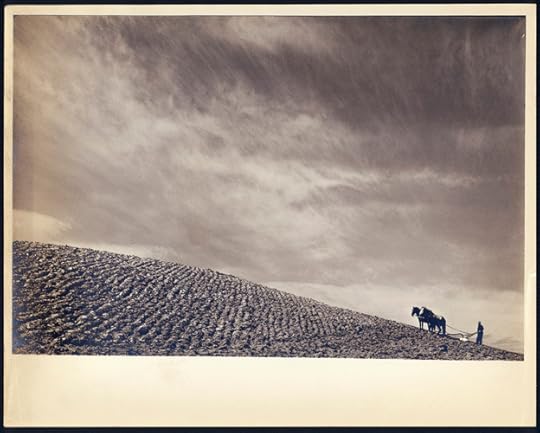Helen Sedwick's Blog, page 9
May 11, 2013
Introducing Keeping It Legal for Writers
I am starting a companion blog today at Keeping It Legal, a step-by-step guide to the legal issues of self-publishing, blogging and marketing your book. For a living I practice law, and I have noticed that many writers find the legal issues quite daunting. Please check out my posts and feel free to ask me questions in the comments sections of Keeping It Legal.
Published on May 11, 2013 09:09
May 4, 2013
History.com's 10 Things You May Not Know About the Dust Bowl
I just discovered that History.com has another list of ten things you may not know about the Dust Bowl. With the on-going drought in the southern plains states, people are growing more concerned about repeating this gritty history.
History.Com
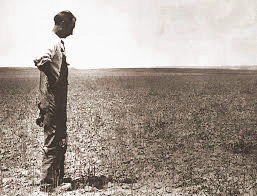
History.Com

Published on May 04, 2013 07:41
April 29, 2013
The Dust Bowl -- Ten Surprising Facts
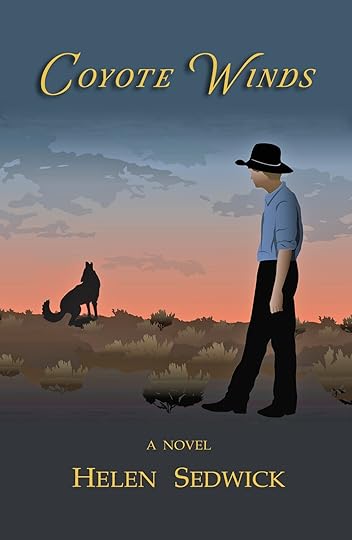 Like many authors writing historical fiction, I researched my time period extensively. I wanted to capture day-to-day life, as well as the attitudes and dreams of people living in past times. In researching the Dust Bowl for COYOTE WINDS, I learned some surprising facts:
Like many authors writing historical fiction, I researched my time period extensively. I wanted to capture day-to-day life, as well as the attitudes and dreams of people living in past times. In researching the Dust Bowl for COYOTE WINDS, I learned some surprising facts:1. The Dust Bowl was a one of the worst man-made ecological disasters in history.
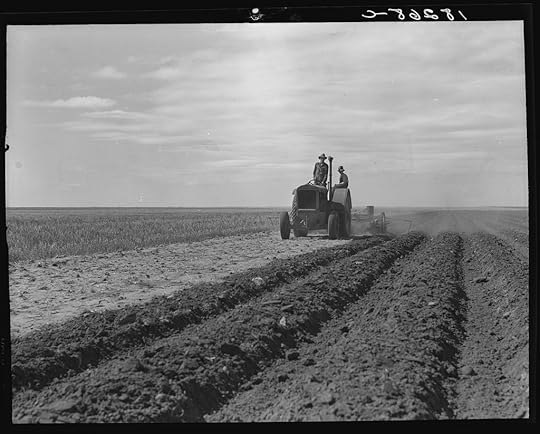 Drought, by itself, did not cause the Dust Bowl. The western Great Plains have always suffered periodic droughts. But native prairie grasses had deep roots, sometimes five to eight feet deep. Even when the above-ground shoots dried up, the roots held the soil in place, and the grasses re-grew quickly when rains returned. During the “Great Plow Up” of the 1920s, farmers torn out prairie grass in an area as large as Ohio. They planted wheat, corn and other shallow-rooted crops. They dreamed of a verdant future because they had been told that “rain follows the plow.” But the rains stopped in 1931, and wind did what it always did—blow. It picked up dust from Montana to Texas, and the Dust Bowl was spawned. The farmers’ dreams gave the wind the weapon that then destroyed those dreams.
Drought, by itself, did not cause the Dust Bowl. The western Great Plains have always suffered periodic droughts. But native prairie grasses had deep roots, sometimes five to eight feet deep. Even when the above-ground shoots dried up, the roots held the soil in place, and the grasses re-grew quickly when rains returned. During the “Great Plow Up” of the 1920s, farmers torn out prairie grass in an area as large as Ohio. They planted wheat, corn and other shallow-rooted crops. They dreamed of a verdant future because they had been told that “rain follows the plow.” But the rains stopped in 1931, and wind did what it always did—blow. It picked up dust from Montana to Texas, and the Dust Bowl was spawned. The farmers’ dreams gave the wind the weapon that then destroyed those dreams.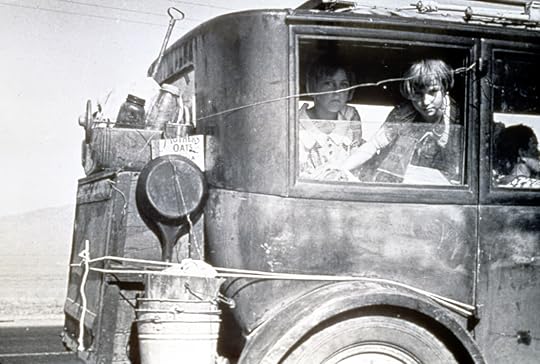 2. Not everyone moved to California.
2. Not everyone moved to California. After John Steinbeck’s novel, The Grapes of Wrath, and the 1940 film, I thought everyone affected by the Dust Bowl moved west. I was surprised to learn that 75% of the people in the Dust Bowl area “stuck it out.” More than 2.5 million people did leave the area, and 300,000 of those went to California. That is a huge migration of economic refugees, but it was scattered over many states.
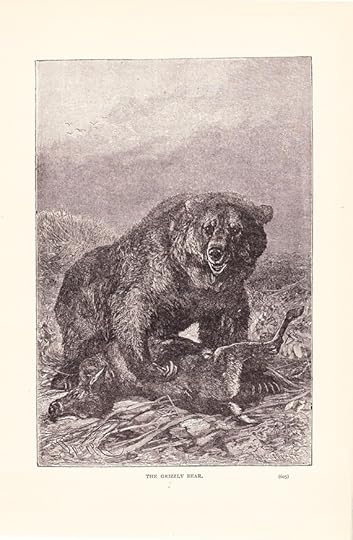 3. Grizzly bears, wolves and bald eagles once were abundant on the Great Plains.
3. Grizzly bears, wolves and bald eagles once were abundant on the Great Plains. Early settlers saw these predators as competition for game and a threat to their livestock. So the animals were poisoned, trapped and hunted relentlessly. And when the buffalo herds were wiped out, the remaining bear, wolf and eagle populations collapsed. That is one reason why coyotes have thrived so well. Their competition was eliminated, and they filled the void.
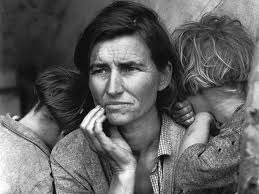 4. Florence Owens Thompson, the mother in Dorothea Lang’s famous photo, was only 32 years old. Hers is a care-worn face if I have ever seen one.
4. Florence Owens Thompson, the mother in Dorothea Lang’s famous photo, was only 32 years old. Hers is a care-worn face if I have ever seen one.5. Dust storms cause high static electricity. Drivers dragged chains behind their cars to ground them; otherwise the engine would short out. If you reached out to shake someone’s hand, the static shock could knock you both off your feet.
6. Dust caused attics to collapse.
People knew enough to brush the heavy dust from their roofs, but many people did not realize that dust was seeping into their attics. Many attics collapsed because the dust was several feet deep.
7. Superstitions were revived.
In the hope of generating rain, farmers killed snakes and draped their bodies belly up along fences. So-called experts used balloons to lift dynamite into the sky. They claimed the explosions “agitated” the atmosphere and caused rain to fall.
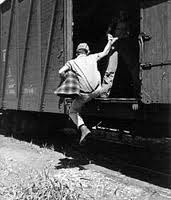 8. In the 1930s, an estimated half-million teenager- were riding the rails as “hobos.”
8. In the 1930s, an estimated half-million teenager- were riding the rails as “hobos.” We tend to think of hobos as grown men, but hundreds of thousands of boys, some as young as ten, left home and rode the rails in search of work and adventure. Some girls joined them. FDR worried that the country would suffer from this lost generation of hardened, wild children.
9. Tumbleweed—that ubiquitous symbol of the West--came from Russia, probably mixed in with early sacks of flax seed.
It is a water-hogging, invasive and hated pest. However cattle will eat the young shoots, so it was used during the Dust Bowl as cattle feed. Some people tried to eat it as well. Unsuccessfully.
10. The Dust Bowl has happened again, although on a smaller scale. Starting in 1952, there was a five-year drought called the “Filthy Fifties.” Another drought hit in the mid-1970s and again between 1998 and 2002. Today the area is experiencing another tough drought. Due to better soil management, dust storms have not been as large and widespread. However if the Ogallala Aquifer ever runs dry (and some people say it will in about 50 years), we are likely to see more dry, abandoned farmland lose soil to the coyote winds.
To learn more about the Dust Bowl, watch the Ken Burns special THE DUST BOWL. The second half will be broadcast on Tuesday April 30, 2013, and it is available on DVD. http://www.pbs.org/kenburns/dustbowl/
My novel, COYOTE WINDS, explores the American can-do spirit that drew people out to the western prairie in the hope of making a new life and feeding the world. And it shows what happened when that spirit came up against the Great Depression and the Dust Bowl. For more information about COYOTE WINDS, visit my website Helen Sedwick Website
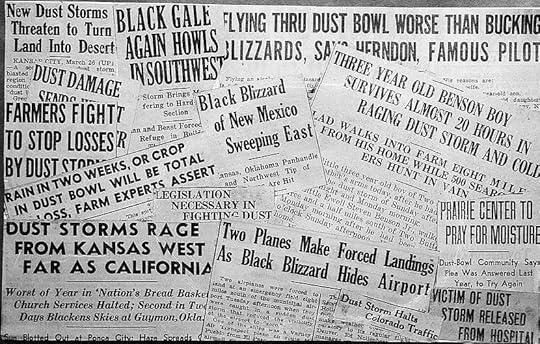
Published on April 29, 2013 15:28
April 22, 2013
Beware--Babies Nearby

It’s Spring, and babies are hiding everywhere. Does tuck their fawns in the tall grass, and quail are nesting in the bottlebrush. Grey foxes have their kits in an old barn down the road. A few years ago, this male kit was so bold he snoozed on our deck.
And out there in the brush are coyote pups. As cute as they may seem, it's best for you and for them to keep your distance.
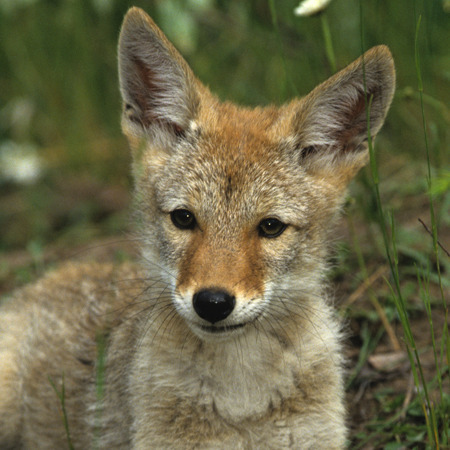
Unlike dogs, coyotes breed once a year. Pups are born in March or April. Weighing approximately 250 grams at birth, they are blind and limp-eared. The eyes open and ears become erect after 10 days. Around 21–28 days after birth, the young begin to emerge from the den, and by 35 days, they are fully weaned. Litter size ranges from one to 15 pups; the average is six. About 50–70% of pups do not survive to adulthood.Female coyotes prefer a dry, safe place to have their pups. A typical den site is a brush and tree pile. Or under the base of a large, standing tree that has an opening at ground level. Coyote pups sometimes are raised in hollow logs and under rock ledges. Most pups are moved several times by the time they are old enough to leave the den on their own. If the pups are too small to follow their mother, she carries them one at a time by the nape of the neck to the new den site.
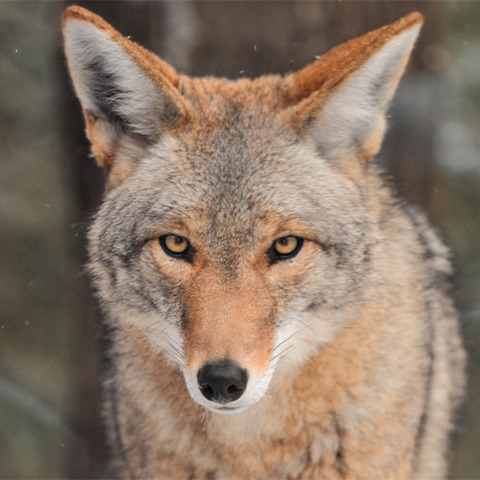 Coyotes are rarely dangerous to humans, except when the pups are threatened. If you see what look like cute, romping puppies in the wild, do not approach them. They may be coyote pups, and the parents may be nearby. Call your local animal rescue service if you fear the pups have been abandoned. Do not try to rescue them yourself.
Coyotes are rarely dangerous to humans, except when the pups are threatened. If you see what look like cute, romping puppies in the wild, do not approach them. They may be coyote pups, and the parents may be nearby. Call your local animal rescue service if you fear the pups have been abandoned. Do not try to rescue them yourself. If the coyotes are coming closer to your home than you’d like, here are some suggestions:
· Do not leave out food or water. Secure your garbage. Move any bird feeder inside a coyote proof fence. Keep small pets inside, particularly at dawn and dusk when coyotes are most active. Try "hazing” techniques. Use noise makers, whistles, and other deterrents. Yell. Act big and scary. The bigger the better. Here are some helpful links:
Humane Society Hazing Techniques
Project Coyote Hazing Brochure
Don’t haze… if it is March through July, and you are in a park or open space and think you could be near a coyote den, or if you think that pups could be present. Allow them breathing room to raise and protect their new families. Be aware that you may encounter a coyote who is trying to haze you away from his den by acting anxious and/or assertive. He may attempt to escort you to a safe distance by hunching his back and walking towards you, or by vocalizing (barking or “huffing”). Please leash dogs and pick up small pets and leave the area calmly. Do not run.
Don’t haze… if the coyote is at a comfortable distance from you. Seeing a coyote at a distance is no cause for alarm. They have adapted to urban environments and may be seen during the day or night.

Published on April 22, 2013 14:11
April 15, 2013
Monday mornings feel like ...
Published on April 15, 2013 12:49
April 11, 2013
New Book Trailer
I made a new trailer, which emphasizes coyotes and nature, as well as a sense of impending doom. I can't get the music out of my head! Tell me what you think.
Coyote Winds trailer
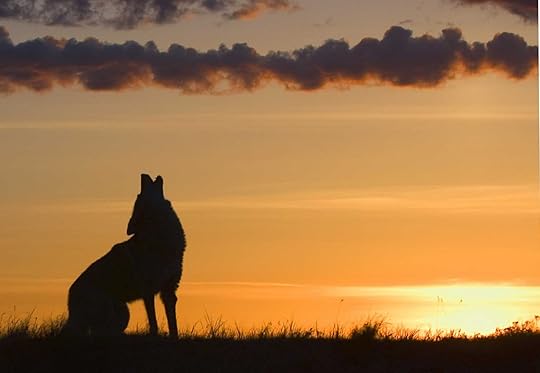
Coyote Winds trailer

Published on April 11, 2013 09:25
April 7, 2013
The Final Chapter of My Father's Words
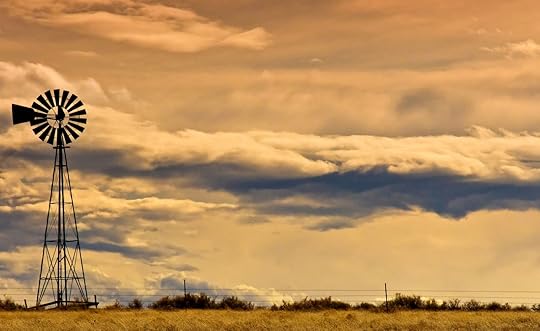
In 1936, we escaped the dust and moved back to Delaware, where my Dad worked for DuPont. I started third grade, after having missed all of first and second grade. Sitting still was downright painful. I talked too much and broke up the class with jokes. In those days, when you misbehaved, teachers pulled you to the front of the room by the ear. My ears grew long that year. As soon as school let out for summer, we loaded up the car and drove back out to Vona. This was years before there were interstates. Only two lane roads that went through every city, town, or hamlet. It was a grueling trip, especially with two boys fussing in the back seat, yelling and hitting at each other. We were not great travelers.
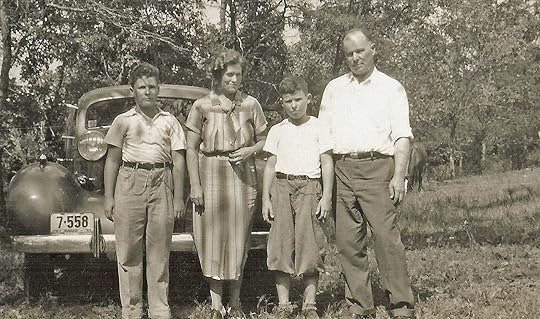 Bob, Grandmother Helen, John, Grandfather Harry We played a lot of that alphabet game where you get the letters out of signs. Always looked for a junction sign to get a J, and Quaker State Motor Oil would give you Q, R, S, T, U - all at once. We had big fights over that sign. Also the Burma Shave signs were all along the roadways. I still remember one of their more catchy ones. "Pity all the mighty Caesars, Had each whisker pulled with tweezers, I Burma Shave." Yeah, my kind of humor.But as soon as we arrived, we were back out hunting and exploring.One summer we took a trip to Colorado Springs and drove up to the top of Pikes Peak in our 1928 Chevy. Quite a trip over a steep, dirt road. In those days the car radiators were not pressure sealed, so they tended to boil over very easily. Going up to the top there were water spigots all along the way, so you could refill your radiator as it boiled over. And the trip down, in low or second gear for breaking help, was quite long.Had a bit of excitement on the way to Colorado Springs. My Aunt Ruth was driving (she never drove much and was a poor driver), and my mother was frightened by something Ruth did and pulled the emergency brake hard. The car went off the road and turned over on its side. Some men came along a few minutes later, stopped, helped us out, and set the car back up on its wheels. We thanked them and were off again, this time with mother driving. The cars in those days were made with such thick sheet metal that there were absolutely no dents in it from turning over. Amazing!In the summer of 1940 we took a trip down through Raton Pass to Taos, New Mexico, then on through Santa Fe and Albuquerque to the Grand Canyon, where we met my uncle, Lyle Vincent, and his family. Spent a few days with them, saw the canyon, then headed back to Colorado.
Bob, Grandmother Helen, John, Grandfather Harry We played a lot of that alphabet game where you get the letters out of signs. Always looked for a junction sign to get a J, and Quaker State Motor Oil would give you Q, R, S, T, U - all at once. We had big fights over that sign. Also the Burma Shave signs were all along the roadways. I still remember one of their more catchy ones. "Pity all the mighty Caesars, Had each whisker pulled with tweezers, I Burma Shave." Yeah, my kind of humor.But as soon as we arrived, we were back out hunting and exploring.One summer we took a trip to Colorado Springs and drove up to the top of Pikes Peak in our 1928 Chevy. Quite a trip over a steep, dirt road. In those days the car radiators were not pressure sealed, so they tended to boil over very easily. Going up to the top there were water spigots all along the way, so you could refill your radiator as it boiled over. And the trip down, in low or second gear for breaking help, was quite long.Had a bit of excitement on the way to Colorado Springs. My Aunt Ruth was driving (she never drove much and was a poor driver), and my mother was frightened by something Ruth did and pulled the emergency brake hard. The car went off the road and turned over on its side. Some men came along a few minutes later, stopped, helped us out, and set the car back up on its wheels. We thanked them and were off again, this time with mother driving. The cars in those days were made with such thick sheet metal that there were absolutely no dents in it from turning over. Amazing!In the summer of 1940 we took a trip down through Raton Pass to Taos, New Mexico, then on through Santa Fe and Albuquerque to the Grand Canyon, where we met my uncle, Lyle Vincent, and his family. Spent a few days with them, saw the canyon, then headed back to Colorado.
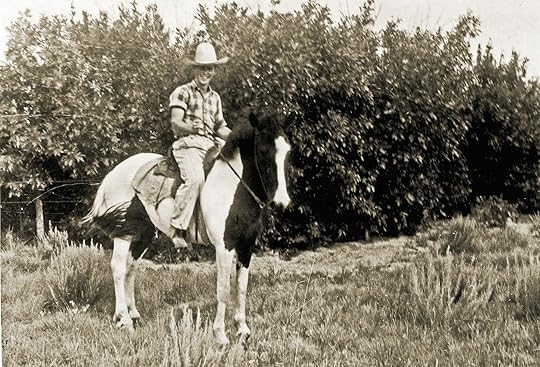 During the summer, Bob and I would lay in the winter's supply of wood and do all sorts of stuff that needed to be done. Sometime during those years we acquired a moveable trailer (like that one that Frank Morgan used in "The Wizard of Oz"), and this became Bob's and my private quarters. Got us out of the house. I suppose it was about 8 by 12, on metal wheels, with steps that led up to the door. One year, right before going back East, I helped Dewey Nelson harvest his wheat for a week. 100 degree temperature, but your shirt never got wet. At that low humidity the sweat evaporated immediately. But, you drank a lot of water. A lot. But I sunburned my lips. They got cracked and bleeding, couldn't hardly eat or talk. A mess! Don't ever sunburn your lips.I went to Vona alone in the summer of 1942. The war was on, and gas was rationed so we couldn't drive. Took the bus out - two days and three nights - and was a horrendous trip. In those days the buses were much smaller than now, bumpier, smaller seats, less leg room, and no lavatories. So, there was a rest stop every couple of hours for fifteen minutes or so. I accomplished by summer chores at the house, but when it came time to return I took the train. Much better form of transportation.That was the last time I saw the place. During the World War II, my grandmother and aunt moved to California, and the land was sold.And so ended my "growing up years" in Colorado.
During the summer, Bob and I would lay in the winter's supply of wood and do all sorts of stuff that needed to be done. Sometime during those years we acquired a moveable trailer (like that one that Frank Morgan used in "The Wizard of Oz"), and this became Bob's and my private quarters. Got us out of the house. I suppose it was about 8 by 12, on metal wheels, with steps that led up to the door. One year, right before going back East, I helped Dewey Nelson harvest his wheat for a week. 100 degree temperature, but your shirt never got wet. At that low humidity the sweat evaporated immediately. But, you drank a lot of water. A lot. But I sunburned my lips. They got cracked and bleeding, couldn't hardly eat or talk. A mess! Don't ever sunburn your lips.I went to Vona alone in the summer of 1942. The war was on, and gas was rationed so we couldn't drive. Took the bus out - two days and three nights - and was a horrendous trip. In those days the buses were much smaller than now, bumpier, smaller seats, less leg room, and no lavatories. So, there was a rest stop every couple of hours for fifteen minutes or so. I accomplished by summer chores at the house, but when it came time to return I took the train. Much better form of transportation.That was the last time I saw the place. During the World War II, my grandmother and aunt moved to California, and the land was sold.And so ended my "growing up years" in Colorado.EPILOGUEAll in all, it was quite an experience. I learned a lot during my time out there - self reliance, ingenuity, improvisation, living with and in solitude with nature. I also learned that nature can be violent, nasty, destroying, and killing. No, you don't fool with Mother Nature.
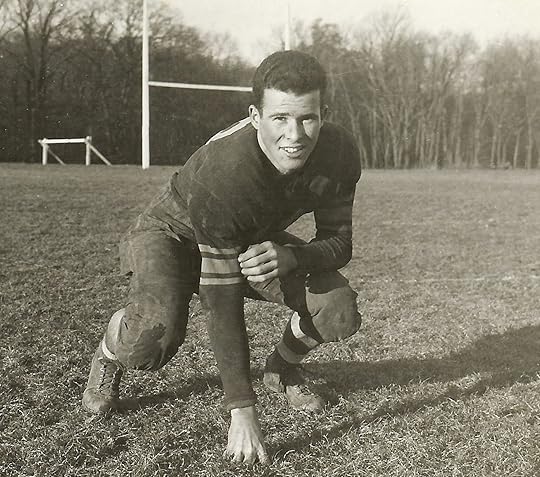 My father John in high school.
My father John in high school.John Sedwick
1927-2008
After the War, my father studied theater at the University of Delaware where he met my mother, Margaret. They were married for over fifty years and had five children and eight grandchildren. John had a long and successful career directing theater and television shows, including DARK SHADOWS, THE EDGE OF NIGHT, and SANTA BARBARA. He kept his sense of humor all his life. Many of the jokes and puns in COYOTE WINDS came from my father. We all still miss him every day.

Published on April 07, 2013 10:49
March 30, 2013
Radios and Rifles--More of my Father's Memoir

EVERYDAY LIFEWhen we first moved out to the timber claim, rural electrification had not come that far, so we had no electricity. Kerosene lamps in the evenings, cooking on a wood burning stove, and no refrigeration. The milk was kept on the North side of the house in the shade, and covered with damp cloths, since evaporation contributes to cooling. But only contributes--not really keeps it fresh. I had to drink so much questionable milk that to this day I won't eat cottage cheese, yogurt, or buttermilk. I got completely turned off on anything milk-wise that wasn't fresh. Hate it!!!After a while we did get a wind charger and hooked it up to batteries, so we had a certainly amount of electricity. Could run a radio, and burn a couple of 25-watt bulbs in the evening. That was about all. The wind charger was on a tower beside the house. One clear night it got stuck by some sheet lightning when I was standing about fifteen feet away. I saw a flash of light overhead, a huge boom, and I was inside that house before that boom was over. Really scared me.
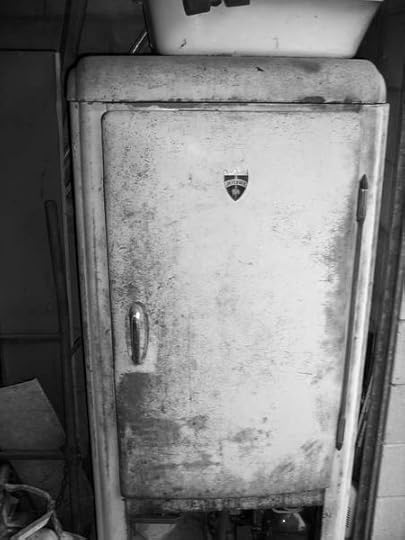 A couple of years later we did get a kerosene refrigerator, so I once again could peacefully drink the milk. It amazed me that a little kerosene flame under the refrigerator would keep everything cold. But it did. We would do a lot of hunting. I got my father's old rifle (a 1903 Winchester) when I was about 9, and my father sent a lot of ammunition that he got when the DuPont company bought some ammo company. Sent them through the mail - don't try that today! We would wander around looking for rabbits or snakes. Even got a couple of pheasants with my 22 caliber rifle - lucky shots, for they were on the wing. But they made good eating.
A couple of years later we did get a kerosene refrigerator, so I once again could peacefully drink the milk. It amazed me that a little kerosene flame under the refrigerator would keep everything cold. But it did. We would do a lot of hunting. I got my father's old rifle (a 1903 Winchester) when I was about 9, and my father sent a lot of ammunition that he got when the DuPont company bought some ammo company. Sent them through the mail - don't try that today! We would wander around looking for rabbits or snakes. Even got a couple of pheasants with my 22 caliber rifle - lucky shots, for they were on the wing. But they made good eating.
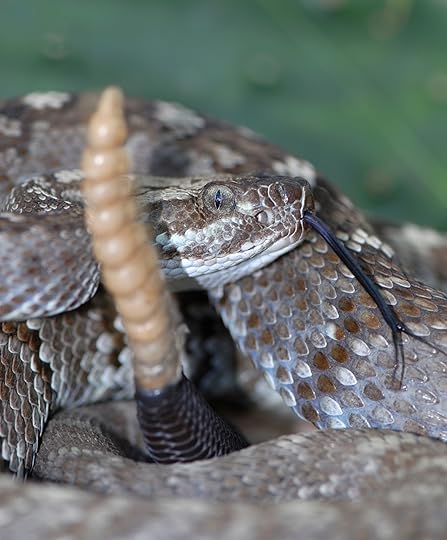 One time I had just rounded a turn in the road, when all of a sudden a rattlesnake breaks the silence with its very loud rattling. After my nerves calmed down, I shot it, waited for it to quit wiggling, and then cut off the rattles as a souvenir. When that rattling breaks the absolute silence out there in the wilds, you are so startled you shake for a few minutes.In this deserted land with no paved roads or state police, everyone learned to drive at an early age. When Bob and I were big enough to see over the hood of the car, and our feet could reach the pedals, we learned to drive. I drove everywhere, even into Vona on occasion. I was probably about ten or eleven when I learned to drive.Sometimes we would go out in the car with Ira Fisher. One of us would drive, with the other two sitting on the front fenders looking for rabbits. Once, during a sharp turn, I fell off and landed on my side, with the rifle on top of me. Picked myself up, dusted myself off, and on we went. One time Ira was using our single shot rifle, and he fired at a distant rabbit just as Bob stepped in front of him. This rifle had a habit of misfiring - which it did this time. Thank heavens, for the shot would have gone right into Bob's neck. Another time I was carrying my gun, and it went off. The bullet hit close to my foot. Glad it missed me. I would hate to have had the embarrassment of shooting myself in the foot.When Bob and I were old enough we would gather firewood for the winter, by cutting down the dead trees and sawing them up to stove size. We had a big bucksaw, a 2-man affair that we used, with the logs on a hand-made saw horse. Once, after a short rest, we started up again, but Bob started before I had a hold of the saw. Well, it went right across my leg, leaving a gash, which slowed us down for that day a bit. I still have a scar. And we would end up with a winter's worth of firewood for my grandmother and aunt to use, along with some coal.
One time I had just rounded a turn in the road, when all of a sudden a rattlesnake breaks the silence with its very loud rattling. After my nerves calmed down, I shot it, waited for it to quit wiggling, and then cut off the rattles as a souvenir. When that rattling breaks the absolute silence out there in the wilds, you are so startled you shake for a few minutes.In this deserted land with no paved roads or state police, everyone learned to drive at an early age. When Bob and I were big enough to see over the hood of the car, and our feet could reach the pedals, we learned to drive. I drove everywhere, even into Vona on occasion. I was probably about ten or eleven when I learned to drive.Sometimes we would go out in the car with Ira Fisher. One of us would drive, with the other two sitting on the front fenders looking for rabbits. Once, during a sharp turn, I fell off and landed on my side, with the rifle on top of me. Picked myself up, dusted myself off, and on we went. One time Ira was using our single shot rifle, and he fired at a distant rabbit just as Bob stepped in front of him. This rifle had a habit of misfiring - which it did this time. Thank heavens, for the shot would have gone right into Bob's neck. Another time I was carrying my gun, and it went off. The bullet hit close to my foot. Glad it missed me. I would hate to have had the embarrassment of shooting myself in the foot.When Bob and I were old enough we would gather firewood for the winter, by cutting down the dead trees and sawing them up to stove size. We had a big bucksaw, a 2-man affair that we used, with the logs on a hand-made saw horse. Once, after a short rest, we started up again, but Bob started before I had a hold of the saw. Well, it went right across my leg, leaving a gash, which slowed us down for that day a bit. I still have a scar. And we would end up with a winter's worth of firewood for my grandmother and aunt to use, along with some coal.
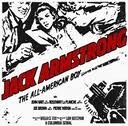 We acquired a radio and set up our private radio network with a few of the neighbors. We ran a wire from our radio to the fence line, erected poles over gates and roads to carry the line up and over any passing vehicles, hooked the wire to our neighbor’s fence, and then ran a line to their house. They had to buy a cheap trumpet-like speaker, but they could listen to the radio, but only to what we had tuned in. Talk about a captive audience. They probably weren't too interested in listening to Bob's and my serials - "Little Orphan Annie," "Tom Mix," or "Jack Armstrong, All American Boy.” But they had a switch and could always turn it off. Then when we got a phone that was hooked up to the national lines, the same neighbors got some cheap phones, and we had our own little network, again using the fences. If they needed to call someone, they would call us and we would relay it on. Of course everything was a party line. You cranked one long one for the operator, who then rang the number you wanted - numbers like, "2 long, and 1 short" - like that. My aunt made a career out of "listening in" constantly. About the only really interesting thing I remember she heard were some girls calling a boy to "meet them down at the graveyard." Gee, wonder what they had in mind?
We acquired a radio and set up our private radio network with a few of the neighbors. We ran a wire from our radio to the fence line, erected poles over gates and roads to carry the line up and over any passing vehicles, hooked the wire to our neighbor’s fence, and then ran a line to their house. They had to buy a cheap trumpet-like speaker, but they could listen to the radio, but only to what we had tuned in. Talk about a captive audience. They probably weren't too interested in listening to Bob's and my serials - "Little Orphan Annie," "Tom Mix," or "Jack Armstrong, All American Boy.” But they had a switch and could always turn it off. Then when we got a phone that was hooked up to the national lines, the same neighbors got some cheap phones, and we had our own little network, again using the fences. If they needed to call someone, they would call us and we would relay it on. Of course everything was a party line. You cranked one long one for the operator, who then rang the number you wanted - numbers like, "2 long, and 1 short" - like that. My aunt made a career out of "listening in" constantly. About the only really interesting thing I remember she heard were some girls calling a boy to "meet them down at the graveyard." Gee, wonder what they had in mind?One last thing. Out there in the middle of no where, my mother and her sister Ruth made Bob and I practice violin. Hated it. Rather be out hunting.
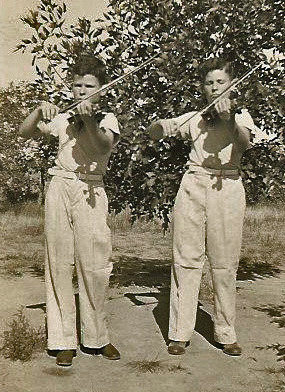
Published on March 30, 2013 18:35
March 26, 2013
My Father's Words Part 3--Dust Storms, Hail and Grasshoppers
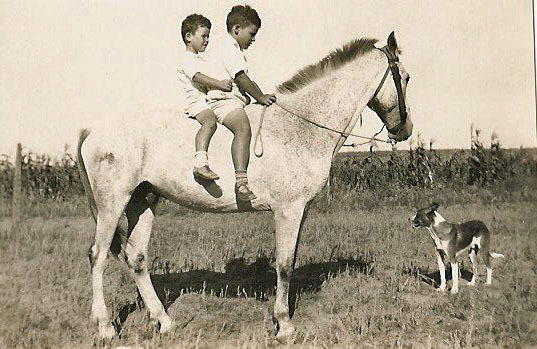
THE GROWING UP YEARSby John Sedwick
THE ENVIRONMENT
DUST STORMS: This was the scourge of the environment. There had been so little rain, and the soil was so dry that it blew with any wind of a little strength. We had it bad up where we were, but it was really much worse down around the panhandle area of Oklahoma.
During World War I, the price of wheat hit the ceiling and stayed high for a time. Land was plowed up to plant more wheat. Then the price of wheat went down, the rains stopped, and all this newly plowed land was ready to blow away. Which it did. For several years the total rainfall was about five inches. That certainly doesn't do much to help raise anything, except dust, and then more dust.
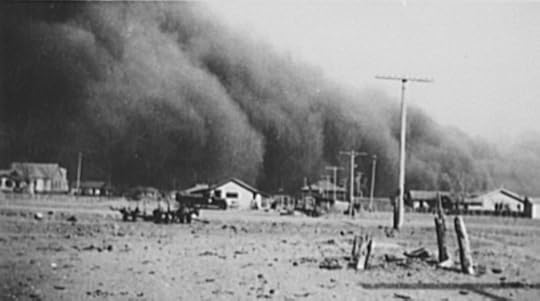 Library of CongressYou would see a dust storm coming hours ahead of its arrival. A brown cloud would form on the horizon, grow larger and larger, until it was filling the sky. About ten minutes before it hit, the wind would die down - sort of like the back draft of a fire - and you ran for the house, closed the door and windows, and waited for it to be over.
Library of CongressYou would see a dust storm coming hours ahead of its arrival. A brown cloud would form on the horizon, grow larger and larger, until it was filling the sky. About ten minutes before it hit, the wind would die down - sort of like the back draft of a fire - and you ran for the house, closed the door and windows, and waited for it to be over.
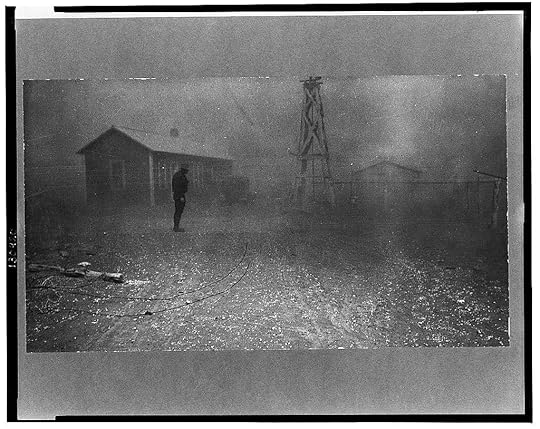 Library of Congress
Library of Congress We had one last for three days - the tail end of a hurricane that came up from Texas. Times we couldn't see fifty feet outside the house. Everything was covered with dust. And there were constantly occurring dust storms - at least one a week.
As I said, there were not as many families moving away as there were down in Oklahoma. Oh, we had some. I remember going to one auction up the road a bit. Stuff going for a quarter, 50 cents, etc. I understand that land was going for $16 an acre. Heard that some of the folks were going to Alaska because the government was giving away homesteads up there. These people were farmers. That's all they knew.
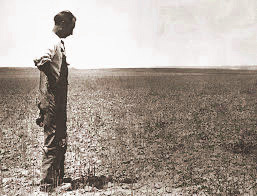 Library of Congress
Library of CongressLIGHTNING: Horrific, frightening, shaking-in-your-boots-time. Multiple streaks of lightning streaking across the sky lighting up the land, followed by loud thunder claps. If it hit a fence line it would split out the fence posts for a quarter of a mile until it grounded out. Rolling in from the West you would see the storms coming. And there wasn't always rain associated with them. Some were dry storms. In the years of drought we could have used some rain, but it didn't always come. And many times the flash would not be completely over before you were rocked with the thunder - the lighting was that close.
HAIL STORMS: You might have three or four bad ones during a summer. You could tell one was coming by the color of the clouds that day - hail clouds were very brown in color. Then you would hear a low rumbling, like a base drum-roll being beaten, and to the West would come a white glaze over the landscape. As it got closer you could see the hail stones, anywhere from marble size to golf ball size. They beat the crops down to the ground, flattened them out. And you didn't want to leave your car out during one of those. Would not be good for it.
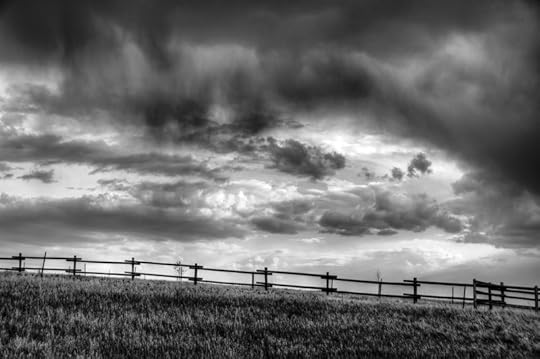
After one bad hail storm all the neighbors gathered up the hail - real ice in the middle of summer, wow! - grabbed some salt, sugar, and milk, and came over to our place and made ice cream. Their crops were ruined, but they had some unheard of ice in the summer - so let's get something good out of all this. And that ice cream was delicious! Whole milk, sugar WOW!
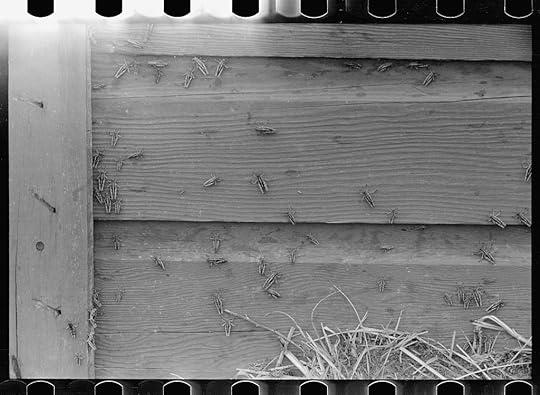 Library of CongressGRASSHOPPERS: They say that in the 1930s, they darkened the sky in China as they were flying over. Well, we never had them that bad, but for several years you could see and hear them flying over, and hopping along all day long. And eating everything as they went. Locusts and grasshoppers of every shape, color, and size. And walking along you kept stepping on them, squashing them. Was quite a plague. It seems that after a few years they died down somewhat, but they had all ready done their damage. Bob and I made a collection of them, pinned them to the inside of cigar boxes. We showed them at school when we came back East.
Library of CongressGRASSHOPPERS: They say that in the 1930s, they darkened the sky in China as they were flying over. Well, we never had them that bad, but for several years you could see and hear them flying over, and hopping along all day long. And eating everything as they went. Locusts and grasshoppers of every shape, color, and size. And walking along you kept stepping on them, squashing them. Was quite a plague. It seems that after a few years they died down somewhat, but they had all ready done their damage. Bob and I made a collection of them, pinned them to the inside of cigar boxes. We showed them at school when we came back East. RABBITS: We were being overrun. Coming back one night from Vona, in ten miles I counted 110 rabbits picked up by our headlights. And those were just the ones I saw. They were eating everything. They were starved by the drought too and wanted to eat. It was either us or them.
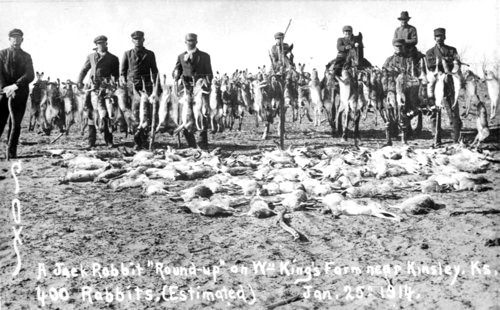
Rabbit hunts were held. A circular fence was set up in about a 100 foot circle, with a funnel-type chute leading to it. All the men and grown boys (we were too young) went out in a big semi-circle, oh, a half mile wide. Then making noise and hollering to scare the rabbits, the crowd started walking toward the chute that led to the pen. One time a coyote got in there, but he escaped before the pen was closed up. Then the men went into the pen and clubbed the rabbits to death. They couldn't shoot them with everybody in this tight proximity, and besides bullets cost money. The state was paying a bounty of two cents an ear, so all the men had a burlap sacks and would cut off the ears and stuff them in a sack. So, you could make some money and help get rid of a real problem at the same time. And, the rabbits were a real problem.
We might shoot a cottontail bunny, and then skin it and eat it, but we never tried it with a jack rabbit. Understand from the locals that you had to boil a jack rabbit for about eight hours to even make it chewable. Not worth it.
THE FLOOD: I think it was 1935, when we had eleven inches of rain come down one night during a six hour period. Looking out the window I could see we were surrounded by water forming a lake around us. We were on a little rise, but the water could not drain away fast enough. But the most amazing thing was that the Republican River, usually a dry river bed, was running a quarter-mile wide and taking everything in its path with it. Even with the rain pounding the roof and the heavy claps of thunder, we could hear that river roaring four miles away. All bridges were gone, so no one got to town for several weeks. Then they had a temporary crossing rigged until a new bridge could be built. And there was water standing in all the adobe low areas. In our pasture the fence ran through one of these adobe low fields. The fence ran down, disappeared, with the water two or three feet above the fence post tops, and then appeared again later as it came out of the depression. It was there for a good six months before it completely dried up.
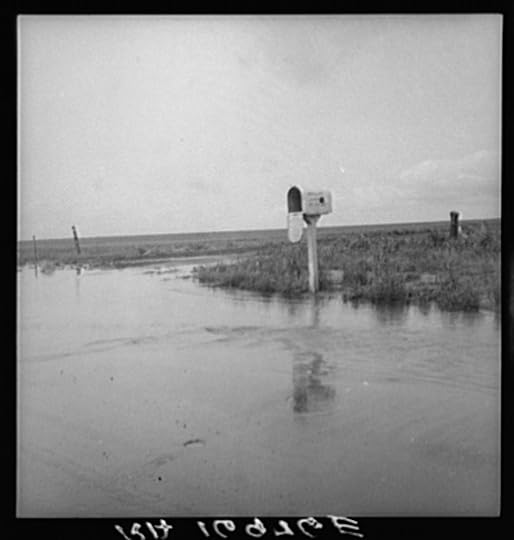 Library of Congress
Library of CongressAnd an amazing thing - within days there were tadpoles swimming around in the ponds, and by a week or so later we were serenaded by the sounds of frogs croaking. Probably the eggs lay dormant in the soil until awakened by the new moisture. But somewhere, somehow they had to get there in the first place. But I will not worry about that.
THE BLOWOUT: This was not an element of the environment, but a victim. This piece of land, about forty acres had been a plowed and planted, then abandoned. It was located on a high area, so there was nothing around to check the force of the winds. The dirt had been blown out, leaving a depressed, scooped out area. The sides of this sandy bottom were about six feet higher than the floor of the area. That's how much dirt had been removed by the winds. This was not a recent happening, but somewhat old. And every school picnic or church gathering visited it. Why? It had once been an Indian campsite, so the area was loaded with lost arrowheads. Probably either a Cheyenne or Arapaho tribe, as they lived in that area. And over the years many were found. You walked around, looking down, hoping to see one. There were four big cottonwood trees beside the blowout (but on the leeward side, as far as wind protection would have been), so that meant there was water not too far down, which made it a good camping ground. There were no other trees in sight.
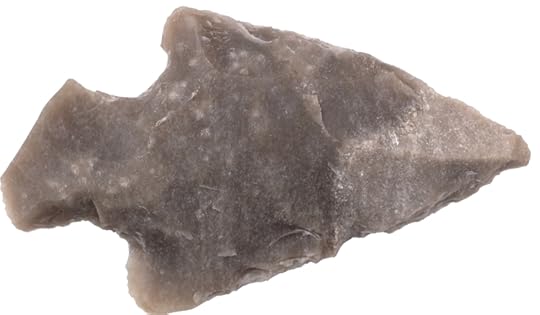 Anyway, I have a collection of arrowheads. The work was so precise, with one a bird arrowhead, only about one inch long, but perfectly shaped. How did they do it so well? Must have taken a lot of patience. Also time, trying to find suitable rocks in this sandy land. I wonder over the years how many arrowheads were found there.
Anyway, I have a collection of arrowheads. The work was so precise, with one a bird arrowhead, only about one inch long, but perfectly shaped. How did they do it so well? Must have taken a lot of patience. Also time, trying to find suitable rocks in this sandy land. I wonder over the years how many arrowheads were found there.
Published on March 26, 2013 13:47
March 24, 2013
My father's words -- Part two
THE GROWING UP YEARSBy John SedwickPART TWO
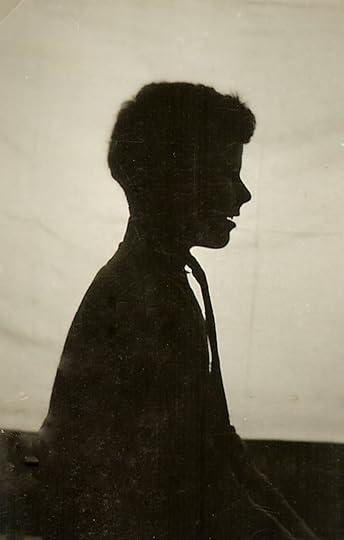 Once the weather got colder, my grandmother decided that three women and two young boys living alone eleven miles from town without a well or electricity didn’t make much sense. We moved closer to town--about one and a half miles from Vona--to a twelve foot by twenty foot shack at Joe Moser's place. Hardly a mansion. A pot-bellied stove was in the center of the room, which was well used in the winter. One night it got down to forty below. All the guinea hens froze up in the windmill by Joe's house. When the sun got warm the next day, they all fell down, frozen.Joe and his wife were real characters. They had two older daughters; well maybe 17 or 18, but to me that was old. They were of German origin and were the area’s brew-meisters. Prohibition was in full force, and they had their own home brewery and did a rather good trade with the locals—lawyers, doctors, sheriffs, all the good citizens desired a brew. To all those customers Prohibition Be Damned!Joe was building our new house right out back of his. When it came time to move up to our property, Joe got the necessary house-moving equipment--wheels, beams, jacks, etc., slid them under the house, started up his tractor, hitched it to the moving rig, and towed the house the ten miles to our new place at about three miles per hour. This was now the new home.The house was to be placed on a rise and among the trees. Deep holes were dug at each corner of the house. Large pieces of junked farm equipment were placed in the holes, and several strands of wire (barbed, as this they had in stock) were attached to them. The holes were filled in with the wires running out of them. The house was lowered in place, and the wires firmly attached to all four corners of the house to serve as anchors for the house. Quite a wind blows constantly, and at times is strong enough to warrant this kind of anchoring. We were in. Before long we had an extension built on the back of the house, an addition for the kitchen, with a bed at the other end. I remember having whooping cough there in that bed. Then there was a garage built for storage and the car. In those days of dust storms, you didn't want to leave the car outside. The storms drove a sandblast that could take the finish right off it. And behind the garage we put the outhouse, a custom-built two-holer with room for the Sears catalogue. A cistern was dug behind the house to store the rainwater. Since water was a precious commodity, you tried to save all you could. With a gutter on the sloping roof, we could divert the rain water into the cistern. We didn't drink or cook with this water, but used it for bathing and household chores.We added a large screened-in porch on one side, about 10 by 10, with a canvas roof on top. Was good in the summer. Where we were in Colorado was at about 4000 feet elevation, so it would cool off at nights. You usually needed a sweater after dark. Actually, the weather, humidity and general weather conditions were very pleasant. But there were times the “gods were angry” and let us have it. More about that later.
Once the weather got colder, my grandmother decided that three women and two young boys living alone eleven miles from town without a well or electricity didn’t make much sense. We moved closer to town--about one and a half miles from Vona--to a twelve foot by twenty foot shack at Joe Moser's place. Hardly a mansion. A pot-bellied stove was in the center of the room, which was well used in the winter. One night it got down to forty below. All the guinea hens froze up in the windmill by Joe's house. When the sun got warm the next day, they all fell down, frozen.Joe and his wife were real characters. They had two older daughters; well maybe 17 or 18, but to me that was old. They were of German origin and were the area’s brew-meisters. Prohibition was in full force, and they had their own home brewery and did a rather good trade with the locals—lawyers, doctors, sheriffs, all the good citizens desired a brew. To all those customers Prohibition Be Damned!Joe was building our new house right out back of his. When it came time to move up to our property, Joe got the necessary house-moving equipment--wheels, beams, jacks, etc., slid them under the house, started up his tractor, hitched it to the moving rig, and towed the house the ten miles to our new place at about three miles per hour. This was now the new home.The house was to be placed on a rise and among the trees. Deep holes were dug at each corner of the house. Large pieces of junked farm equipment were placed in the holes, and several strands of wire (barbed, as this they had in stock) were attached to them. The holes were filled in with the wires running out of them. The house was lowered in place, and the wires firmly attached to all four corners of the house to serve as anchors for the house. Quite a wind blows constantly, and at times is strong enough to warrant this kind of anchoring. We were in. Before long we had an extension built on the back of the house, an addition for the kitchen, with a bed at the other end. I remember having whooping cough there in that bed. Then there was a garage built for storage and the car. In those days of dust storms, you didn't want to leave the car outside. The storms drove a sandblast that could take the finish right off it. And behind the garage we put the outhouse, a custom-built two-holer with room for the Sears catalogue. A cistern was dug behind the house to store the rainwater. Since water was a precious commodity, you tried to save all you could. With a gutter on the sloping roof, we could divert the rain water into the cistern. We didn't drink or cook with this water, but used it for bathing and household chores.We added a large screened-in porch on one side, about 10 by 10, with a canvas roof on top. Was good in the summer. Where we were in Colorado was at about 4000 feet elevation, so it would cool off at nights. You usually needed a sweater after dark. Actually, the weather, humidity and general weather conditions were very pleasant. But there were times the “gods were angry” and let us have it. More about that later.

Published on March 24, 2013 19:21

